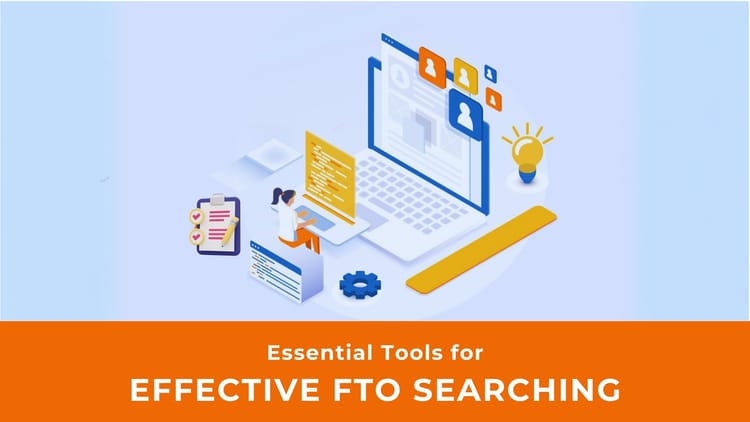What is Freedom to Operate (FTO) Search?
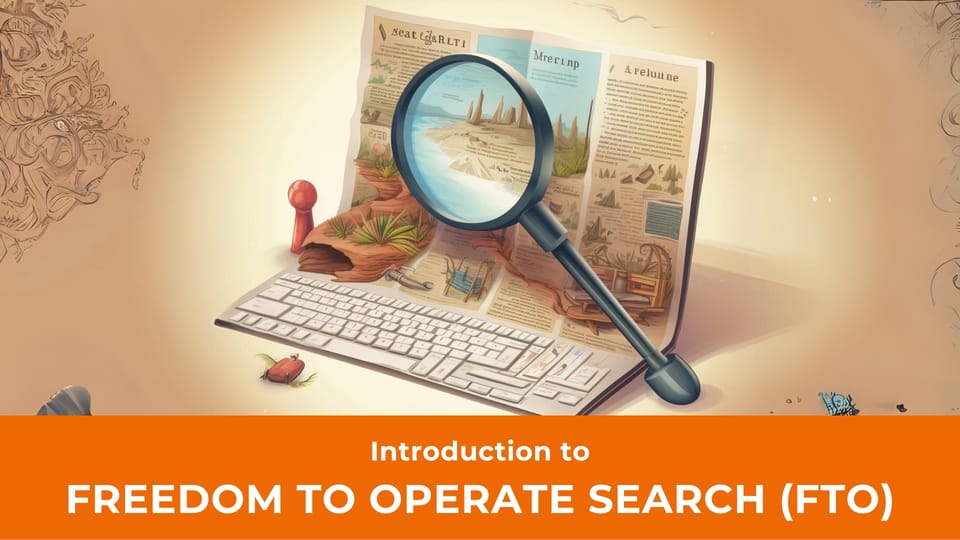
What is Freedom to Operate?
Freedom to Operate refers to the ability to launch a product, process, or service without infringing on the intellectual property rights of others. It's a crucial consideration for businesses and innovators navigating the complex landscape of patents and intellectual property (IP).
In legal terms, FTO ensures that a new development does not infringe existing patent rights. It involves carefully analyzing issued patents and pending applications to evaluate potential risks.
Beyond its legal implications, FTO is a strategic business tool. It helps companies identify potential patent barriers and assess the risk of patent infringement before investing significant resources in development and marketing.
Importance of FTO in the Patent Landscape
Risk Mitigation: FTO searches are essential for mitigating legal risks in the intricate world of patents. By identifying potential patent infringements early, companies can avoid costly legal disputes and redesign efforts.
Innovation and Competition: FTO plays a pivotal role in fostering innovation. By understanding the existing patent landscape, businesses can identify gaps and opportunities for new inventions, staying ahead in a competitive market.
Global Relevance: With the increasing globalization of business, FTO becomes even more critical. Companies must navigate domestic and international patents, making FTO searches a complex yet indispensable part of business strategy.
How FTO Affects Businesses and Innovators
Product Development: FTO directly impacts the product development cycle. Identifying potential patent infringements early allows businesses to make informed decisions about design, development, and go-to-market strategies.
Investment Decisions: Investors often require an FTO analysis before committing funds. A clear FTO can increase confidence, attracting more investment and support.
Strategic Planning: FTO is not just a one-time activity but a continuous process. It informs strategic planning, helping businesses navigate the evolving patent landscape and adapt their strategies accordingly.
Cross-Industry Impact: The relevance of FTO extends across industries. From pharmaceuticals to technology, understanding the freedom to operate is fundamental for any sector dealing with innovation and IP.
Guide on Conducting an FTO Search
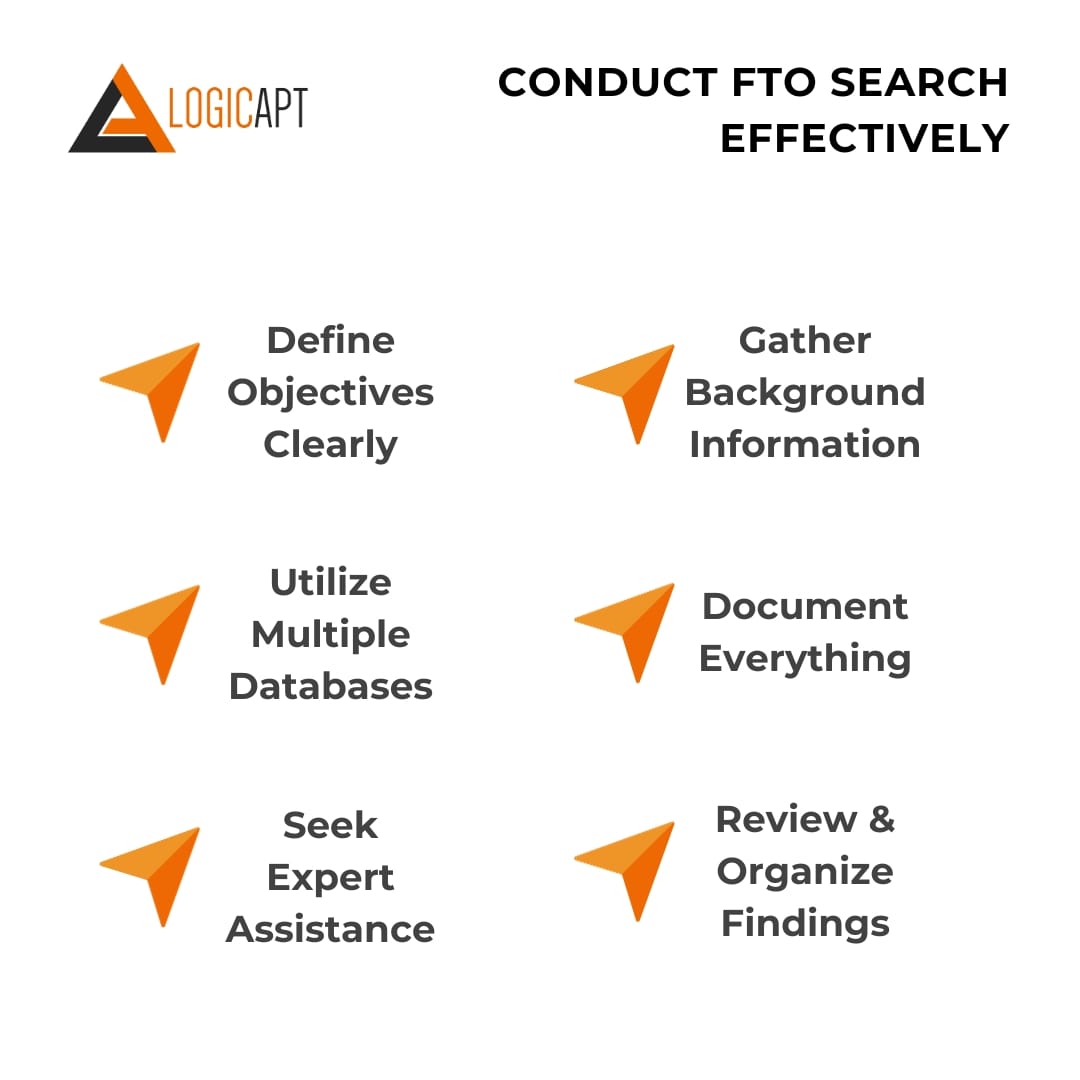
Step 1: Define the Scope
- Identify the product, process, or service to be examined.
- Determine the key features or components that may involve patent considerations.
Step 2: Collect Patent Data
- Use various databases to gather relevant patents and patent applications.
- Include global databases for a comprehensive search, especially if the product has international market potential.
Step 3: Analyze Patent Claims
- Focus on the claims section of patents, as this defines the scope of the patent holder's rights.
- Use professional judgment or seek expert advice to interpret technical and legal language.
Step 4: Document Your Findings
- Keep detailed records of all searches and analyses.
- This documentation is crucial for legal protection and future reference.
Tools and Resources for Effective FTO Searches
Patent Databases:
- Utilize platforms like USPTO, EPO, WIPO, and other national patent offices.
- Consider subscription-based services for more comprehensive searches.
Software Tools:
- Employ specialized software for patent search and analysis.
- These tools often provide advanced search capabilities and analytics.
Freedom to Operate Analysis
Step-by-Step Process of Analyzing FTO Results
Interpreting Patent Data:
- Assess the relevance of identified patents to your product.
- Understand the legal status of these patents (active, expired, pending).
Evaluating Risk:
- Determine the likelihood of infringement based on patent claims.
- Consider seeking legal opinions for high-risk areas.
Strategizing:
- Develop strategies to mitigate identified risks, such as redesign, licensing, or challenging the validity of relevant patents.
Case Studies and Examples
Practical Scenarios:
- Present real-world examples of FTO searches and their outcomes.
- Highlight strategies employed to overcome challenges.
Understanding FTO in the Context of Patents
Patent Types and Their Impact:
- Differentiate between utility, design, and plant patents.
- Understand how each type affects FTO considerations.
Legal Considerations:
- Grasp the nuances of patent law as it relates to FTO.
- Stay updated with changes in patent legislation and case law.
Navigating Patent Databases for FTO
Effective Search Strategies:
- Develop skills in keyword searching, classification searching, and advanced techniques.
- Utilize database-specific features and tools for efficient searching.
Keeping Up-to-Date:
- Regularly monitor for new patents and legal developments.
- Establish alerts or use services that provide updates relevant to your field.
FTO Patent Search Techniques
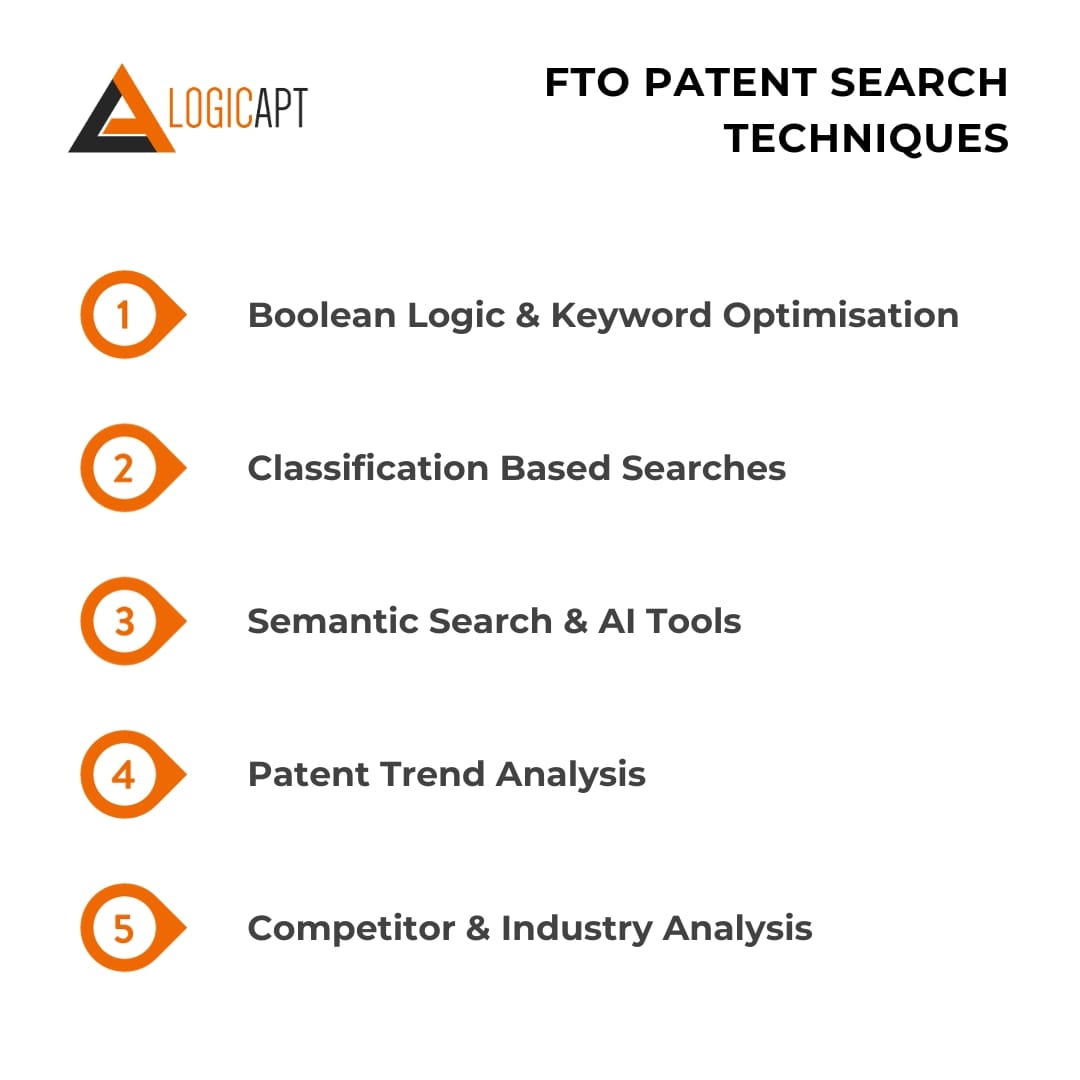
Advanced Search Strategies
Boolean Logic and Keyword Optimization:
- Utilize Boolean operators for more targeted search results.
- Refine keyword strategies based on patent language and technical terminology.
Classification-Based Searches:
- Leverage patent classification systems like the Cooperative Patent Classification (CPC) for precise filtering.
- Understand how to navigate complex classification hierarchies.
Semantic Search and AI Tools:
- Incorporate AI-powered search tools that understand the context and semantics of search terms.
- Use these tools to uncover hidden connections and relevant patents that traditional methods might miss.
Utilizing Analytics and Big Data
Patent Trend Analysis:
- Employ analytics tools to identify patent filings, granting patterns, and litigation trends.
- Analyze these trends to predict future challenges and opportunities in FTO.
Competitor and Industry Analysis:
- Monitor patent activities of competitors and industry leaders.
- Use this data for strategic planning and to anticipate market movements.
Comprehensive FTO Analysis Methods
In-Depth Legal and Technical Review
Detailed Claim Analysis:
- Conduct a thorough examination of patent claims for nuances and potential infringement risks.
- Engage with patent experts or legal professionals for specialized insights.
Freedom to Operate Opinions:
- Consider obtaining formal FTO opinions from legal experts.
- Use these opinions for risk assessment, litigation preparedness, and investment decisions.
Risk Assessment and Mitigation Strategies
Risk Matrix Development:
- Create a risk matrix to evaluate the severity and likelihood of potential patent infringements.
- Prioritize risks based on this matrix for efficient resource allocation.
Mitigation Techniques:
- Explore various risk mitigation strategies like licensing, patent pooling, or design-around options.
- Evaluate the feasibility and cost-effectiveness of these strategies.
Sector-Specific FTO Studies
Pharmaceuticals and Biotechnology
Regulatory Interface:
- Understand the interplay between patent law and regulatory approvals (e.g., FDA approval processes).
- Navigate patent term extensions and exclusivity periods.
Biologics and Biosimilars:
- Dive into the complexities of FTO in the context of biologics and biosimilars.
- Address unique challenges such as molecular variability and patent thickets.
Technology and Electronics
Software Patents:
- Address the challenges of software patents, including abstract ideas and rapidly evolving technology.
- Understand the nuances of software-related IP in different jurisdictions.
Emerging Technologies:
- Explore FTO considerations in cutting-edge fields like AI, IoT, and blockchain.
- Stay ahead of the curve by monitoring patent trends and emerging legal issues.
How to Conduct an FTO Search Effectively
Preparation and Planning
Define Objectives Clearly:
- Establish clear goals for the FTO search. Are you assessing a specific product, technology, or market?
- Determine geographical scope: Will the search be global or focused on specific regions?
Gather Background Information:
- Collect detailed information about the product or technology in question.
- Understand the technological field and related patent classifications.
Conducting the Search
Utilize Multiple Databases:
- Search across various patent databases, including USPTO, EPO, and WIPO.
- Consider using specialized databases relevant to your industry.
Document Everything:
- Keep meticulous records of search queries, results, and rationales.
- This documentation is vital for supporting your FTO conclusions.
Seek Expert Assistance:
- Consider consulting with patent attorneys or search experts, especially for complex technologies.
After the Search
Review and Organize Findings:
- Systematically review all identified patents and applications.
- Categorize findings based on relevance and potential impact.
Interpreting FTO Results
Understanding Patent Claims
Claims Analysis:
- Focus on interpreting the claims of identified patents.
- Consider how these claims may relate to your product or technology.
Validity and Enforceability:
- Assess the validity and enforceability of relevant patents.
- Check for any legal challenges or disputes that might affect patent strength.
Assessing Risk
Identify Potential Infringements:
- Highlight any areas where your product or process might infringe on existing patents.
- Consider the likelihood and potential impact of such infringements.
Develop Contingency Plans:
- Plan for possible redesigns, licensing negotiations, or legal challenges.
Best Practices in FTO Analysis
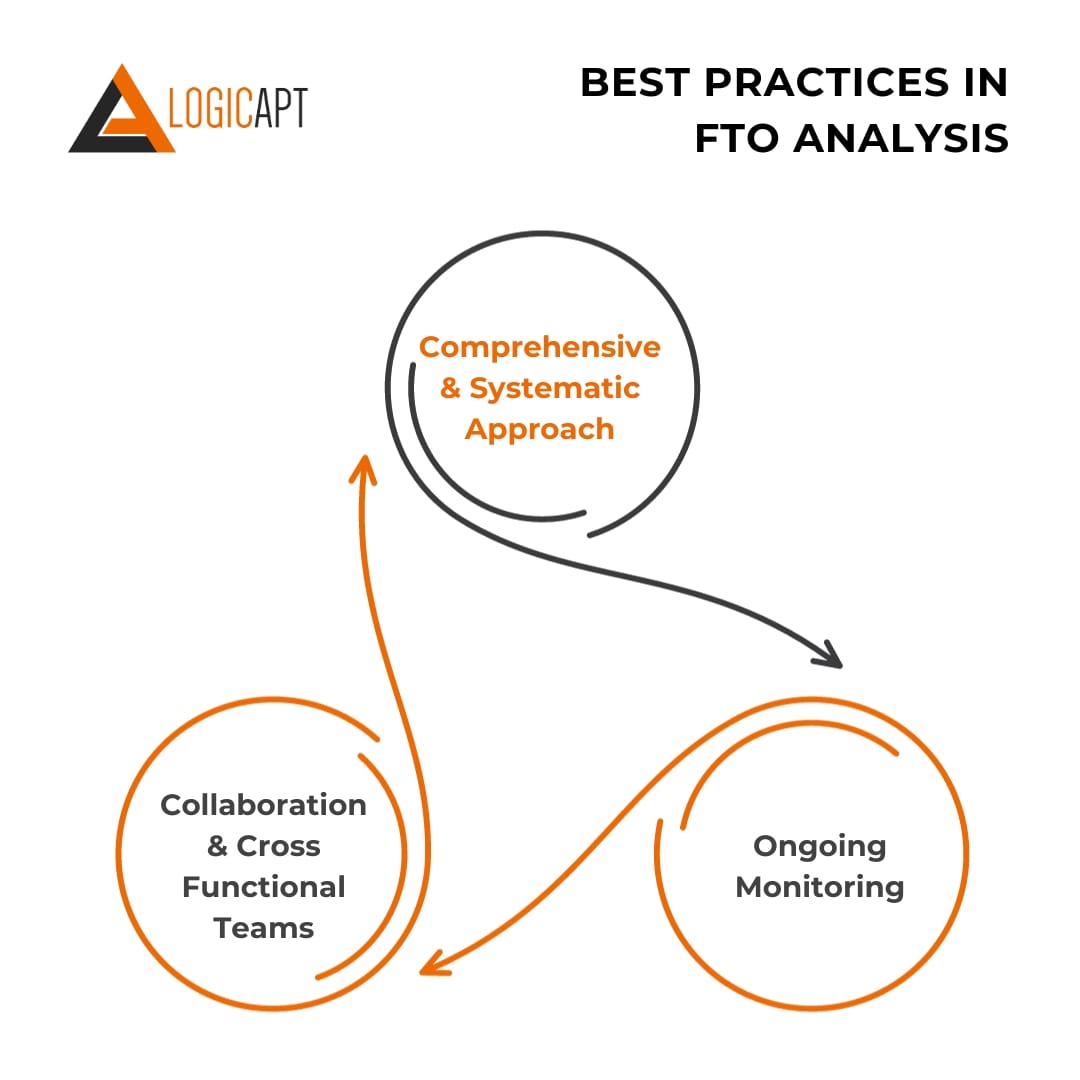
Comprehensive and Systematic Approach
Cover All Bases:
- Ensure the search is comprehensive, covering all relevant technology aspects and jurisdictions.
- Regularly update the search to include new patent filings and legal developments.
Collaboration and Cross-Functional Teams
Engage Multiple Perspectives:
- Involve legal, technical, and business teams in the FTO process.
- Utilize their diverse expertise to gain a well-rounded view of FTO risks and opportunities.
Ongoing Monitoring
Stay Informed:
- Implement a system for ongoing monitoring of the patent landscape.
- React promptly to new patents, legal decisions, and market developments that might affect FTO.
Legal and Ethical Considerations in Freedom to Operate
Understanding the Legal Framework
Patent Laws and Regulations:
- Discuss the fundamental principles of patent law that govern FTO.
- Highlight key legal distinctions across different jurisdictions.
Infringement and Liability:
- Explain what constitutes patent infringement in the context of FTO.
- Explore the potential legal consequences of infringing on existing patents.
Legal Strategies and Defenses
Avoiding Infringement:
- Offer strategies for avoiding infringement, such as design-around techniques or seeking licensing agreements.
- Discuss the legal process and considerations in challenging the validity of a patent.
Litigation Considerations:
- Provide an overview of what litigation entails in the context of patent infringement.
- Discuss defense strategies and the importance of solid FTO research in legal disputes.
Ethical Aspects in FTO Searches
Conducting Ethical Searches
Transparency and Integrity:
- Emphasize the importance of conducting FTO searches with honesty and transparency.
- Discuss the ethical implications of intentionally overlooking relevant patents.
Ethical Use of FTO Information
Respecting Intellectual Property:
- Highlight the ethical responsibility to respect the IP rights of others.
- Discuss the balance between innovation and IP rights protection.
Confidentiality and Privacy:
- Address the ethical considerations in handling sensitive information during FTO searches.
- Outline best practices for maintaining confidentiality and privacy.
Social and Environmental Considerations
Impact on Innovation:
- Discuss the ethical role of FTO in fostering or hindering innovation.
- Explore the implications of FTO on small businesses and startups versus large corporations.
Global and Societal Impact:
- Examine the broader societal and environmental impacts of FTO decisions.
- Discuss ethical considerations in sectors with significant social impacts, such as healthcare and sustainability.
FTO Case Studies and Real-World Examples
Case Study 1: High-Tech Startup Navigates a Crowded Space
- Background: A small startup in the renewable energy sector developed a novel solar panel technology.
- Challenge: Facing a dense patent landscape with numerous existing patents.
- Action: Conducted an exhaustive FTO search, identifying potential patent barriers.
- Outcome: Successfully avoided infringement by adjusting design and secured venture funding due to clear FTO.
Case Study 2: Biotech Firm's Strategic Licensing Success
- Background: A biotech company developed a new gene-editing technique.
- Challenge: Discovered potential infringement on a broad-use patent.
- Action: Engaged in strategic negotiations for licensing the patent.
- Outcome: Entered into a mutually beneficial licensing agreement, allowing market entry without legal disputes.
Case Study 3: Pharmaceutical Innovation Inspired by FTO
- Background: A pharmaceutical company sought to develop a new drug for a rare disease.
- Challenge: Identified several existing patents on similar compounds.
- Action: Used FTO findings to steer research toward unexplored compounds.
- Outcome: Developed a patentable and commercially viable new drug, filling a market gap.
Case Study 4: Electronics Manufacturer Dodges Litigation
- Background: A manufacturer developed a new type of wearable fitness tracker.
- Challenge: Discovered a potential infringement on a competitor's patent.
- Action: Conducted a thorough FTO analysis, then redesigned the product.
- Outcome: Launched the product without legal challenges, saving on litigation costs.
Case Study 5: Tech Company's Agile Response to FTO Findings
- Background: A tech company developed an innovative AI-based customer service tool.
- Challenge: FTO analysis revealed a high risk of infringement on existing AI patents.
- Action: Redesigned certain features and algorithms to circumvent patent issues.
- Outcome: Successfully launched the tool, showcasing the company's agility and innovation.
Case Study 6: Global FTO Strategy for Automotive Manufacturers
- Background: An automotive manufacturer developed a new electric vehicle (EV) technology.
- Challenge: Needed to navigate diverse patent landscapes in multiple countries.
- Action: Implemented a comprehensive global FTO strategy, including local patent law considerations.
- Outcome: Successfully launched the EV in various international markets without infringing local patents.
Conclusion and Future of Freedom to Operate
As we've explored throughout this pillar, FTO is not static; it is a field in constant flux, shaped by technological advancements, legal developments, and global market trends. The rise of new technologies, such as AI, biotech, and renewable energy, has brought new complexities and challenges to FTO. Moreover, the globalization of commerce and the increasing interconnectivity of patent systems worldwide add complexity to FTO searches and analyses.
Key Evolutions:
- Technological Advancements: Rapid innovation, especially in fields like AI and biotech, is creating a more crowded and complex patent landscape.
- Globalization: As businesses expand globally, the need for comprehensive, international FTO searches increases.
- Legal Developments: Ongoing changes in patent laws and IP regulations across different jurisdictions impact FTO strategies.
Predictions and Trends in FTO Searches
Looking ahead, several trends and predictions can be identified that will shape the future of FTO:
1. Increased Reliance on AI and Machine Learning:
- Advancements in AI will enhance the efficiency and accuracy of FTO searches.
- Expect more sophisticated tools capable of semantic search, trend analysis, and predictive insights.
2. Greater Emphasis on Cross-Disciplinary Expertise:
- FTO will increasingly require a blend of legal, technical, and business knowledge.
- Professionals with cross-disciplinary skills will be in high demand.
3. Focus on Proactive FTO Strategies:
- Companies will adopt more proactive approaches to FTO, integrating it into the early stages of product development.
- This shift aims to mitigate risks and reduce potential costs associated with late-stage infringement issues.
4. Expansion of FTO in Emerging Markets:
- As innovation spreads globally, FTO searches will expand to include emerging markets with growing IP infrastructures.
- This will necessitate an understanding of diverse legal systems and patent environments.
5. Ethical and Social Responsibility in FTO:
- There will be a growing focus on the ethical implications of FTO decisions, especially in sensitive sectors like healthcare and sustainability.
- Companies will be expected to balance IP rights with broader societal interests.




